March 6, 2015
Air Date: March 6, 2015
FULL SHOW
SEGMENTS
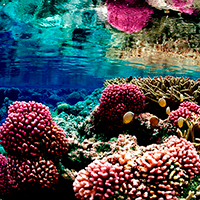
Newly Discovered Algae Helps Corals In Warming Oceans
View the page for this story
Coral reefs are a delicate ecosystem. Their health largely relies on the symbiotic relationship between algae and corals, which typically breaks down in warmer water. But as Jörg Wiedenmann Professor and Head of University of Southampton’s Coral Reef Laboratory tells host Steve Curwood, a new species of algae is allowing corals in the Persian Gulf to withstand rising ocean temperatures. (06:35)

Pond Scum May Be Associated With ALS and Alzheimer's
View the page for this story
Blue-green algae is actually a type of bacteria that proliferates due to excess nutrients in streams and lakes. It can be toxic to humans and animals and may be associated with liver and neurological disorders. As University of Montreal biologist Zophia Taranu (Taran-YOO) tells host Steve Curwood, these poisonous bacteria are blooming more frequently in waters around the world as the world warms. (06:50)
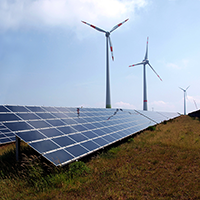
States Reconsider Renewable Standards
View the page for this story
Many states have instituted Renewable Portfolio Standards, that require a proportion of energy needs be met by green power, rather than fossil fuels. But as the Clean Energy States Alliances’s Executive Director Warren Leon tells host Steve Curwood, despite better technology, public support and tax incentives, some states are looking to roll back their renewables policies. (08:00)
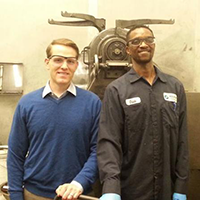
Advances In Storage for Renewable Energy
/ Kara HolsoppleView the page for this story
Increasing amounts of energy comes from renewable sources like solar and wind, but it’s hard to store the excessnfor times when that’s not available. But as the Allegheny Front’s Kara Holsopple reports, better battery technologies and funding could help make renewable energies a more viable alternative to fossil fuel power. (04:00)

Beyond the Headlines
/ Peter DykstraView the page for this story
In this week’s trip beyond the headlines, Peter Dykstra tells host Steve Curwood about pollution lawsuits that settle for too little, a climate change documentary that went viral in China, and a bat that roosts in Monty Python and the Holy Grail’s famed castle. (04:30)

BirdNote: Eating Well Together
/ Mary McCannView the page for this story
Many species of birds dine alone, avoiding competition for food, but the temperate woodlands’ chickadees, kinglets and downy woodpeckers forage and feast better together—rustling up more food than they would alone while keeping a watch for predators. (01:50)
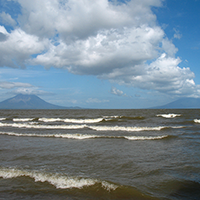
Nicaraguan Canal Could Be Environmental Catastrophe
View the page for this story
The Panama Canal has been the only shipping route through the Americas since it was built in the 1890s. Now a Chinese company has a concession to build a competing canal through Nicaragua, but biologist Jorge Huete-Perez warns host Steve Curwood the project could have serious consequences for the people and environment of Nicaragua. (10:20)

Listener Letters and A Fun Lesson on Thermodynamics
/ Michael Flanders and Donald SwannView the page for this story
We address your comments on one of our stories, and also revisit the laws of thermodynamics with the British comedy duo Michael Flanders and Donald Swann. (05:00)
Show Credits and Funders
Show Transcript
HOST: STEVE CURWOOD
GUESTS: Jorg Wiedenmann, Zophia Taranu, Warren Leon, Jorge Huete-Pérez
REPORTER: Kara Holsopple, Peter Dykstra, Mary McCann
[THEME]
CURWOOD: From Public Radio International, this is Living on Earth.
[THEME]
CURWOOD: I'm Steve Curwood. The discovery of a new species of algae in the Persian Gulf might offer a way to help coral reefs stressed by rising sea temperatures and pollution.
WIEDENMANN: Coral reefs are by no way doomed, so corals try to fight back and they try to adjust to the changing environment and they have a higher capacity to do so then we had previously thought, but this will not be enough.
CURWOOD: Also, the quest for better ways to store renewable energy. Economies of scale are helping bring down prices on some types of batteries.
WILEY: Before it was on the order of 10 or 20 x too expensive. Now it’s starting to get to a price point where in certain instances, it looks reasonable.
CURWOOD: That story, chickadees, kinglets, Donny woodpeckers and more this week on Living on Earth. Stick around.
[NEWSBREAK MUSIC: Boards Of Canada “Zoetrope” from “In A Beautiful Place Out In The Country” (Warp Records 2000)]
ANNOUNCER: Support for Living on Earth comes from United Technologies – innovating to make the world a better, more sustainable, place to live.
Newly Discovered Algae Helps Corals In Warming Oceans
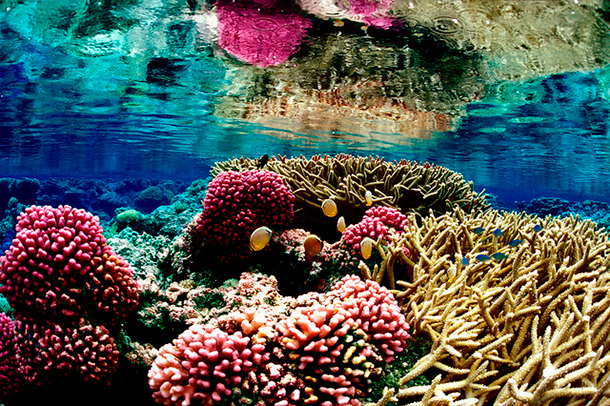
Researchers have discovered a new species of algae that can survive higher ocean temperatures. Corals depend on the symbiotic relationship to survive. In turn, this enables the coral host to withstand warmer waters as well. (Photo: USFWS Pacific; Flickr CC BY 2.0)
CURWOOD: From the Jennifer and Ted Stanley Studios in Boston and PRI, this is Living on Earth. I’m Steve Curwood. Today we have some good news, as well as some bad and definitely ugly, and it all has to do with algae...well, not quite, but we’ll explain a bit later. So let’s start with the good, and it’s good news for coral reefs, which are in trouble in many spots around the world. Overfishing and pollution aren’t helping, but the big challenge seems to be shifting water temperatures, which can drive out the algae that reefs depend on for food from photosynthesis, leaving the reefs unhealthy or dead and bleached a ghostly white. Now science has discovered a species of algae in the Persian Gulf that doesn’t seem to mind high or low ocean temperatures. Jorg Wiedenmann of the University of Southampton was part of the team that made the discovery.
CURWOOD: Jorg, welcome to Living on Earth.
WIEDENMANN: Hi there, it's a pleasure to be here.

Some types of algae live symbiotically inside a coral host, photosynthesizing to feed the coral sugars and receiving shelter and nutrients in return. (Photo: Jörg Wiedenmann, J. Burt, C. D’Angelo)
CURWOOD: So, first of all, why study corals in the Persian Gulf? What's unique about that region?
WIEDENMANN: The Persian Gulf is actually a wonderful natural laboratory because they are experiencing temperatures, which are predicted for other parts of the world for the next century. So, if we want to get a better idea of what will be going on in other oceans, the Persian Gulf might be telling us already the future since the corals are experiencing heat already there.
CURWOOD: Now, why is it that warmer than average ocean temperatures typically are a problem for corals as a result of bleaching.
WIEDENMANN: So corals live together in a symbiotic relationship with this unicellular algae and they depend on their algal symbiont because they provide them with valuable nutrients and food. However, this symbiotic relationships is very vulnerable and if temperatures exceed a certain threshold the algae for the photosynthesis is not working properly anymore and they produce some toxic compounds which results in a breakdown of symbiotic relationship and the algae are lost from the coral. So, as a consequence the white skeleton of the animal close to the coral is shining through the tissue and that gives these corals the bleached appearance and that is actually a signal that they are severely stressed, that they have lost their symbiotic partner and as a consequence they might actually die if they do not manage to recover in this environment.
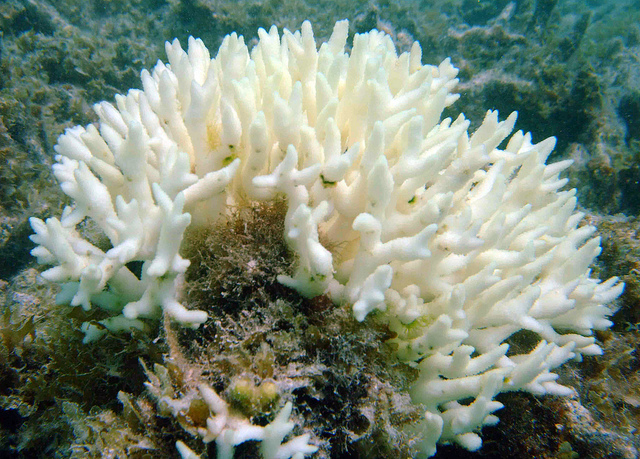
Coral bleaching results when the coral host loses its algal symbiont. Most species of algae living symbiotically inside corals can’t survive warmer waters; without algae, corals starve. (Photo: Scientific Editor; Flickr CC BY-NC-SA 2.0)
CURWOOD: But you found this particular alga that can survive warm temperatures, at least greater temperature fluctuations than species known to be outside the gulf. How is this alga able to do that?
WIEDENMANN: At the moment we don't know yet how they manage to do it. The only thing that we know now and this is very exciting, that this is very new type of algae and obviously this algae is doing something very different from the algae in other parts of the world, and our future research will hopefully help find out what mechanism is by which they manage to survive these extreme temperatures.
CURWOOD: What's a potential for this particular species of algae to live symbiotically with other coral species in other places, maybe places that are under stress because of warming ocean temperatures?
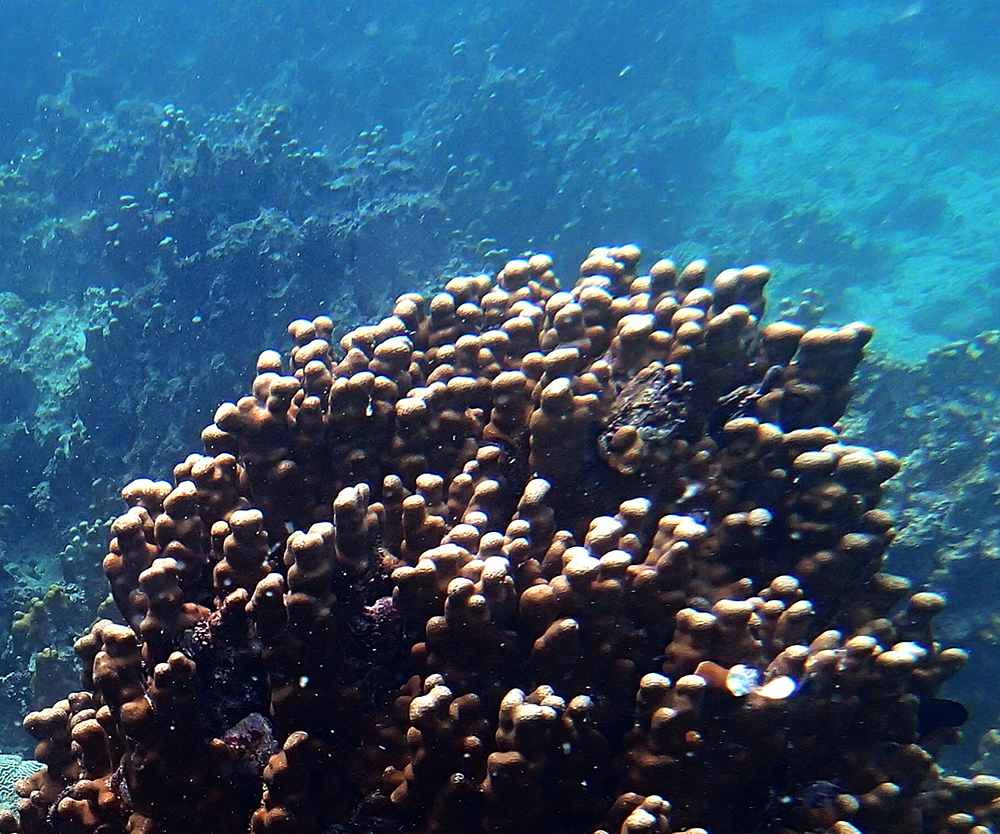
The algae living symbiotically inside corals give their hosts a brown color, seen here in a coral of the Porites genus in an Abu Dhabi reef. (Photo: Jörg Wiedenmann, J. Burt, C. D’Angelo)
WIEDENMANN: Well, so the exciting finding about that is that corals obviously have more means to adjust to high temperatures than we previously thought. In the past it was just one strain of algae, which was made mostly responsible for thermal tolerance in corals and now we certainly know that there are even different species, which could do that. So that means that the diversity of algae out there that could actually help corals to survive in extreme temperatures might be much bigger than we had previously thought. And when temperatures are rising in other parts of the ocean these algae actually might take over and help the corals to become more temperature tolerant. However, while this gives hope that corals will adjust to the increasing temperatures of the future, one also needs to be realistic about that and if we look at the Persian Gulf so we find there are about 68 coral species that can endure in these high-temperature environments. If you look in a more normal tropical environment in the Indo-Pacific, the hotspot of coral diversity, you would find about 600 species. So obviously, there are limitations to the adaptation potential of corals to these extreme temperatures. It does not mean that rising ocean temperatures are nothing bad for corals, because they can acclimate to a certain extent.
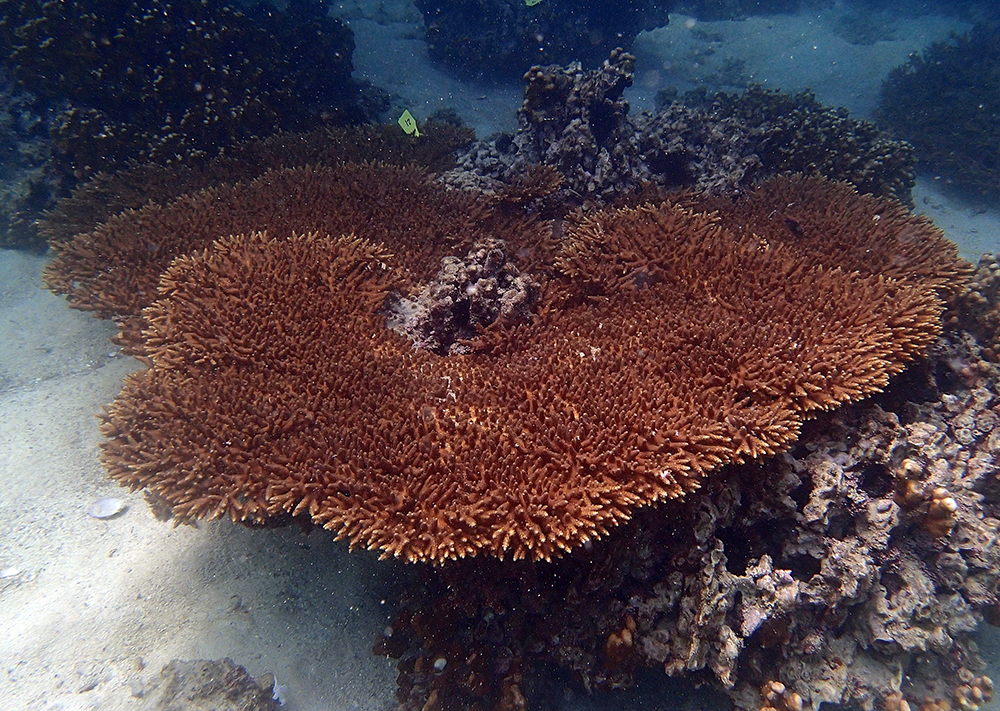
Researchers found the heat-tolerant algae species in the Persian Gulf, where ocean temperatures can reach 96 degrees Fahrenheit. (Photo: Jörg Wiedenmann, J. Burt, C. D’Angelo)
CURWOOD: In your work what other stressors do you see besides heat that threaten coral reefs?
WIEDENMANN: Water quality plays a crucial role for coral survival and our recent work has shown that for example, nutrient enrichment of waters, which corals receive can actually lower the temperature tolerance. The temperature threshold at which corals can start to bleach and start to suffer is actually lowered. So this is something very important because that also gives possibilities to really actively promote coral reefs to become more resilient towards temperature increases. If we managed to get the water quality right in coral reefs then they are actually are more resilient towards temperature stress.
CURWOOD: So, Jorg, what's the message here? What's the message that this new finding sends us about the future of coral reefs?
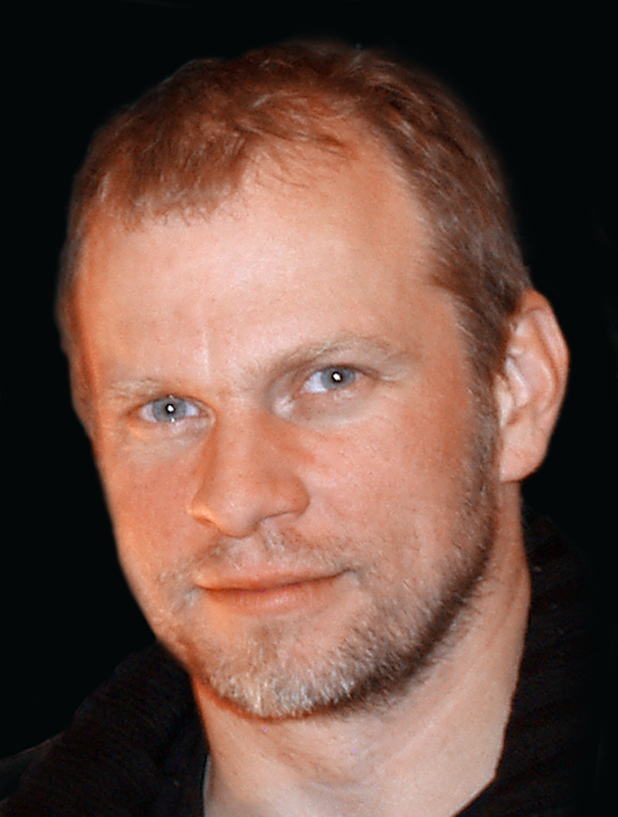
Jörg Wiedenmann is a professor of biological oceanography and head of the coral reef laboratory at the University of Southampton. (Photo: courtesy of Jörg Wiedenmann)
WIEDENMANN: So, what we can see is that coral reefs are by no way doomed, so corals try to fight back and they try to adjust to the changing environment and they have a higher capacity to do so then we had previously thought, but the important message is that this will not be enough. We need to support coral reef ecosystems in their struggle to adjust to higher temperatures and reduce the pollution of the waters, reduce overfishing and to keep them in natural and good health.
CURWOOD: Jorg Wiedenmann is a Professor of Biological Oceanography and head of the Coral Reef Laboratory at the University of Southampton. Thanks so much for taking the time with us today.
WIEDENMANN: Thank you very much for talking. It was great fun.
Related links:
- The paper in the journal Nature
- “Newly Discovered Algae Could Save World’s Coral From Climate Change”
- About Jörg Wiedenmann
- The Coral Reef Laboratory at the University of Southampton
Pond Scum May Be Associated With ALS and Alzheimer's
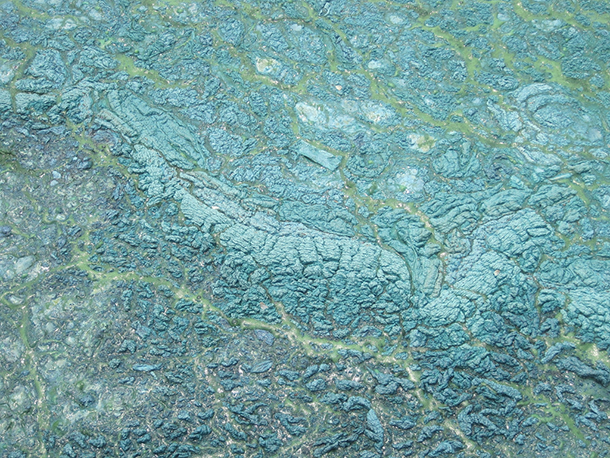
Blue green algae, or more accurately, cyanobacteria (Photo: Lake Improvement Association; Flickr CC 2.0)
CURWOOD: And now, algae’s bad and ugly side - pond scum. It isn’t just a summer nuisance. New international research led from Canada suggests that blue green algal blooms are growing around the world and could threaten our health. Indeed, last August, authorities in Toledo, Ohio banned residents from drinking their water due to excess levels of a toxin produced by algae in Lake Erie. And some scientists are suggesting an association of the increase in blue green algae with diseases ranging from liver tumors to Alzheimer’s and other neurological disorders. Zophia Taranu is a Biologist at the University of Montreal and the lead author of a new paper in Ecology Letters. Welcome to Living on Earth.
TARANU: Thank you very much.
CURWOOD: So, first off, what is blue-green algae?
TARANU: So, blue-green algae is actually a bacteria that produces a blue-green pigment. More recently, we called them cyanobacteria.
CURWOOD: Huh. So why did we think that they were algae?
TARANU: Because they have a lot of the similar characteristics as algae or phytoplankton, but what differs is that they don't have membrane bound organelles that would make them algae.
CURWOOD: So, you looked at this bacteria to see how it's doing around the world. Tell me about your study?
TARANU: So the motivation behind our study was that there has recently been an increased attention in the media and also people living around lakes that there was possibly an increased occurrence of these blue-green algae or cyanobacteria in lakes. But we didn't know whether or not it was a true increase or if people were just paying more attention, and there's also the suggestion that we, with global warming and changes to the land use that we are creating these opportune conditions for an increase in cyanobacteria. As so our study was really motivated to try and quantify whether or not cyanobacteria are increasing over time.
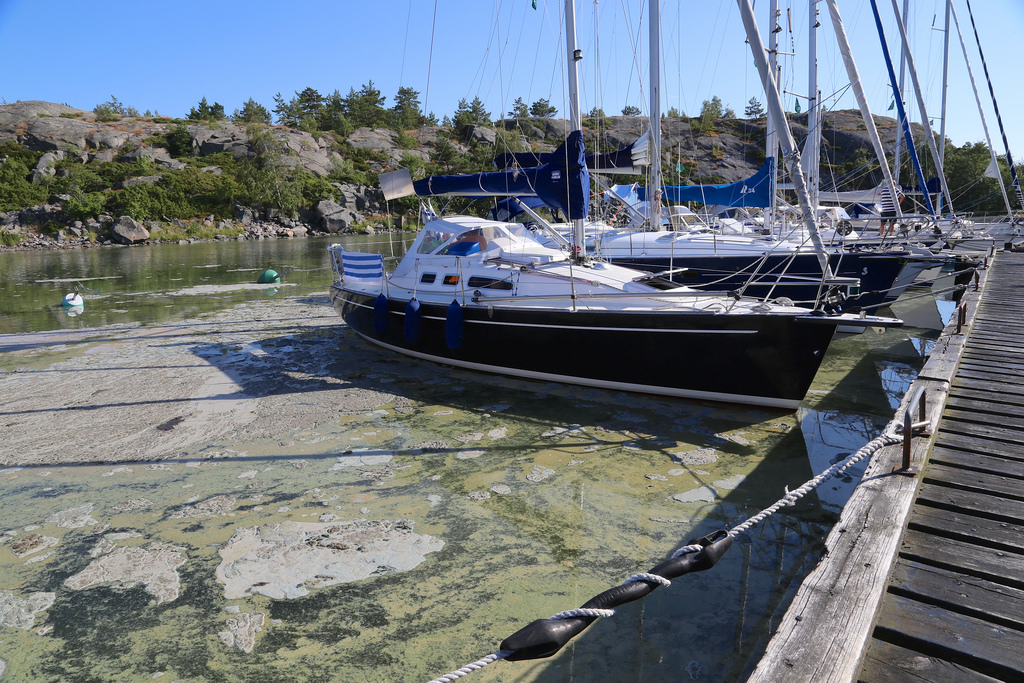
Cyanobacteria blooms like this one are on the rise around the world (Photo: Jukk_a; Flickr CC 2.0)
CURWOOD: And what did you find?
TARANU: So we found that over the past 200 years cyanobacteria have been increasing significantly, and that the increase was accentuated or accelerated since particularly the 1960s and this coincided with that changes in modern agricultures, so the application of fertilizers and also coincided with increases in the global temperature.
CURWOOD: Now, what you suppose is causing this global rise all around the world in blue-green algae or actually it's bacteria.
TARANU: So what we found in our study and has being shown at local scales as well is that the increase in fertilizer coming from the land into lakes is driving this increase so, cyanobacteria do really well when the concentration of phosphorus and nitrogen, these nutrients that we are applying on the land are high and they can outcompete phytoplankton during those conditions.
CURWOOD: Yes, I'm thinking the summer of 2014, Toledo, Ohio had to stop drinking water from Lake Erie because of a bloom like this. What happened there?
TARANU: That particular bay has a lot of agriculture land nearby so there is more of a loading of nutrients that happens. And typically cyanobacteria forms these blooms or these scums on the surface water, and what happened in Lake Erie in 2014 was that there were strong winds that recirculated the blooms towards the bottom waters which is where that filtration plants take their water supplies and so basically there was these toxic blooms that make their way into the water supply.
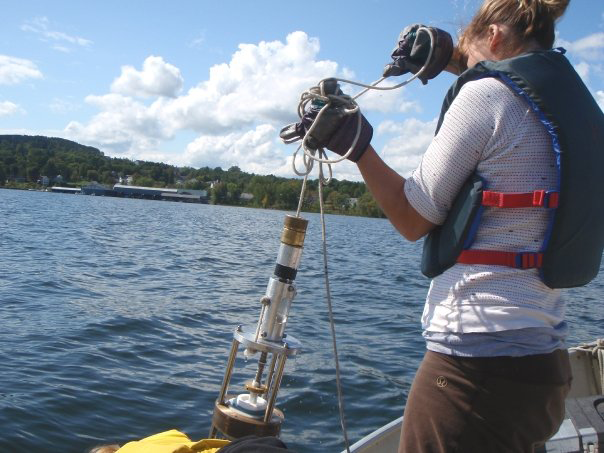
Biologist Zophia Taranu testing lake water. (Photo: Victoria Shaw)
CURWOOD: So what are some impacts of cyanobacteria on our health?
TARANU: Some of them not all cyanobacteria produce toxins, but when they do bloom there is a higher occurrence of toxins being produced, and so in some cases, for example, there's been instances where livestock and pets that consume lake water that had blooms that were toxic died as a result. Typically humans don't consume lake water that has blooms in them because it has a bad taste and odor problem, so there's no known report of deaths of humans, but there is still that toxic effect. When you have direct contact, you can have skin irritations or gastrointestinal discomforts, from swimming in the water and being in contact with the blooms. More long-term effects could potentially be related to the fact that the most common cyanobacteria produce these liver toxins so it can have liver tumors that produce over a longer-term scale, but this is still speculative. There has also been studies that have correlated whether or not residents who live close to a lake and the occurrence of certain neurodegenerative diseases. This latter link is still really controversial in the literature, and something that I think we need to look into more closely into future years. The truth is we don't actually know if that link is present or not.
CURWOOD: What kind of neurological disorders are suspect?
TARANU: So some studies have linked it to ALS for example, and they found that residents that live closer to lakes, there is a correlation or higher occurrence of ALS, but because it's a correlation, it doesn't imply causation, so there could be other factors, for example, living nearby agriculture fields that have fertilizer applications or being in a large city with other environmental issues that could be a play. So even though it's a correlation we don't actually know if it's a cause.
CURWOOD: So, ALS, what other disorders?
TARANU: There was one study, for example, in Guam, around 2003 that found a certain population that consumed bats that themselves consumed the trees that had a symbiotic relationship that produced cyanobacteria. And within these patients they found symptoms that they said were descriptive of neurodegenerative diseases such as Parkinson's and Alzheimer's, so the symptoms were comparable and in the cerebral tissues of the patient had died of these neurodegenerative diseases they found what they call a bioamplification of the cyanobacteria protein. But to the best of my knowledge that's the only known case of this amplification.
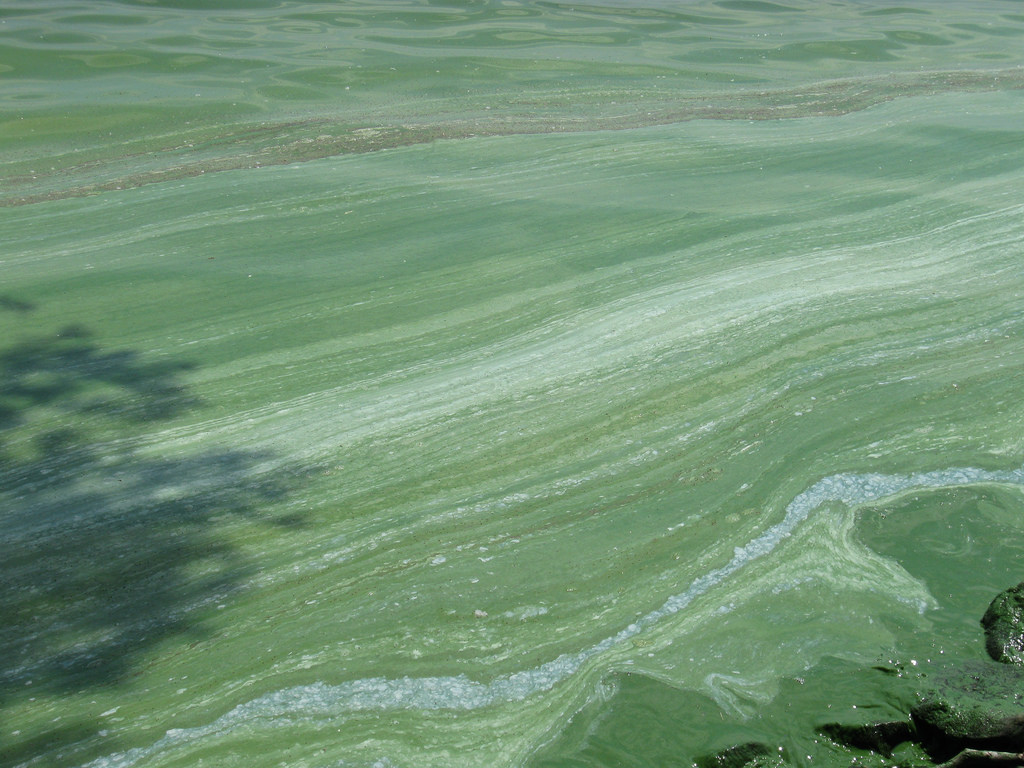
Cyanobacteria is a common pond scum. (Photo: Wisconsin Department of Natural Resources, CC 2.0)
CURWOOD: So what are the steps you think we need to take to reduce the amount of the cyanobacteria in our waterways?
TARANU: The two dominant factors that we found in our study: the most important one was the loading of nutrients from agricultural land or the concentration of nutrients in lakes. There's also climate warmings. I think climate warming is a bit of a harder issue to tackle, and people are trying to work on this continuously. The overuse of fertilizers in the agricultural land is probably something that will be more easily tackled in future years because we're currently applying... in about 70 percent of croplands across the world we're applying phosphorous in excess of need and so the quota and the mitigation needs to be applied at that end as we saw that as the primary driver of cyanobacteria.
CURWOOD: Zophia Taranu is a Biologist at the University of Montréal. Thanks so much for taking the time with us today, Zophia.
TARANU: Thank you very much for having me.
Related link:
Read more about Zophia Taranu’s study
[MUSIC: Steve Winwood and Traffic--Low Spark of the High-Heeled Boys, The Swimming Hour]
CURWOOD: Coming up...with renewable energy in the US on the rise some states are looking to slow down that growth. Stay tuned to Living on Earth.
[CUTAWAY MUSIC: Alberto Mesirca--Farewell to Stromness, British Guitar Music, Paladino 2012]
States Reconsider Renewable Standards
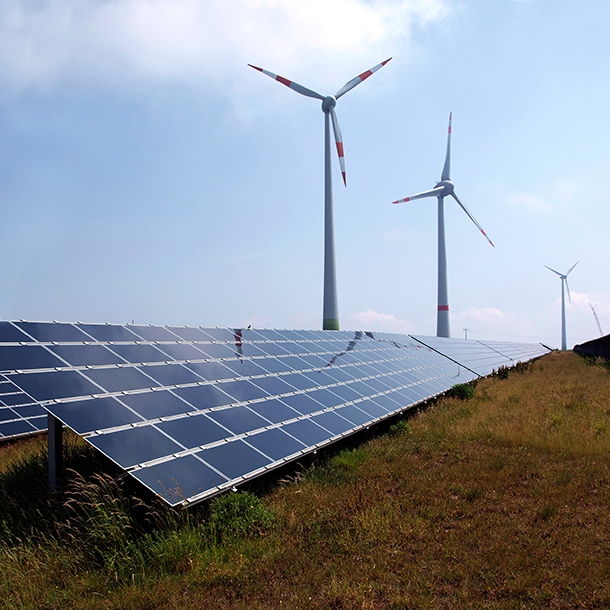
Germany’s wind-energy park "Schneebergerhof” (Photo: Armin Kübelbeck; CC BY-SA 3.0)
CURWOOD: It's Living on Earth. I'm Steve Curwood. Renewable energy is having its moment in the sun, accounting for about 40 percent of newly installed power in the US in 2013. This growth is boosted by tax incentives, and broad public support. Yet backing at state government level is eroding. Some states that have required a certain percentage of electric power to come from green sources - so called “renewable portfolio standards” - are looking to trim or even eliminate those mandates. Warren Leon is the Executive Director of the Clean Energy States Alliance and he with us now to explain the pushback. Welcome to the Living on Earth.
LEON: Thanks for having me on the show.
CURWOOD: Warren, what are renewable energy portfolio standards and what's their function?
LEON: Renewable portfolio standards are a requirement that the electricity suppliers in the state get a certain share of their electricity from renewable energy, and the way they're normally set up is that the amount of renewable electricity they need to get every year goes up slightly and that drives the development of additional wind, solar, biomass and other renewable energy facilities in this country.
CURWOOD: And what states have those at this point?
LEON: There are 29 states plus the District of Columbia.
CURWOOD: Walk me through the renewable portfolio standard of, well, any state of your choosing.
LEON: Well, it really varies. Every state does it differently. Some states allow different technologies than other states. In some cases it's just restricted to the most typical renewable energy sources, things like wind, solar, biomass. Some states include small hydro; other states don't include small hydro. Some states include things like fuel cells; other states don't include fuel cells. Some states allow things like combined heat and power. So it really varies from state to state.
CURWOOD: Tell me the kind of difference that renewable portfolio standards have made in a place like California. How much less fossil fuel are they using there?
LEON: California, they have a very aggressive renewable portfolio standard or RPS, by the year 2020 they have to get 33 percent of their electricity from renewable sources. So there would've been some renewable energy development anyway, but it's probably the case that 15 percent of electricity that may have come from fossil fuels is coming from renewables simply because of the existence of that RPS.
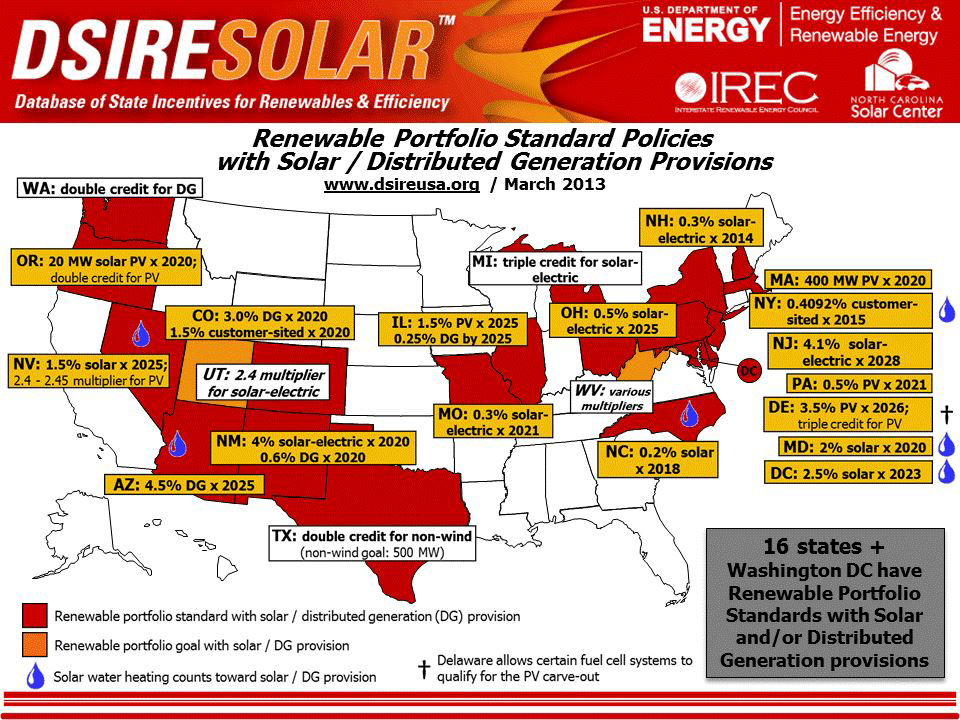
States with renewable portfolio standards, including solar or distributed generation provisions, as of March 2013. (Photo: Database of State Incentives for Renewables & Efficiency)
CURWOOD: Now, as I understand it, a number of states are looking to roll back renewable portfolio standards. Why is there this resistance now to something that, well, obviously saves fossil fuel energy.
LEON: Well we can't necessarily say states are trying to roll it back. The important thing to keep in mind is that renewables remain widely popular on a bipartisan basis in states across the country. Having said that, there are certain groups that would like to see the RPS roll back, and they really have three motivations. One is fossil fuel interests that are trying to attack and weaken the competition. Secondly, although renewable development has economic benefits for the state, it does lead to slightly higher electricity costs, the costs from most states has been less than 2 percent, but it's still a real increase. And third there are some folks who have philosophical objections to any government policy that seems to be interfering with a completely free and open marketplace.
CURWOOD: What about what happened in Ohio? 2014 saw legislation to dump renewable portfolio standards there.
LEON: Yes there was a move in Ohio to eliminate or reduce the renewable portfolio standard. And a lot of folks in the business community came out in support of the renewable portfolio standard because they saw that renewable energy development was good for jobs and business growth in the state. And so what they ended up doing was putting it on hold for two years while they're going to study the situation. It's going to come up again, but the fact that it was not eliminated or completely rolled back shows that there are powerful public interests that still push for retaining that.
CURWOOD: There are number states that this is under discussion I think, what, Indiana, Illinois, Georgia, Texas and Oklahoma, Maryland, Kansas...as I understand it their renewable portfolio standard is being challenged in the legislature this year. It comes up year after year. What happens in these debates and why does repeal of renewable portfolio standards seem to lose every time in Kansas, at least so far?
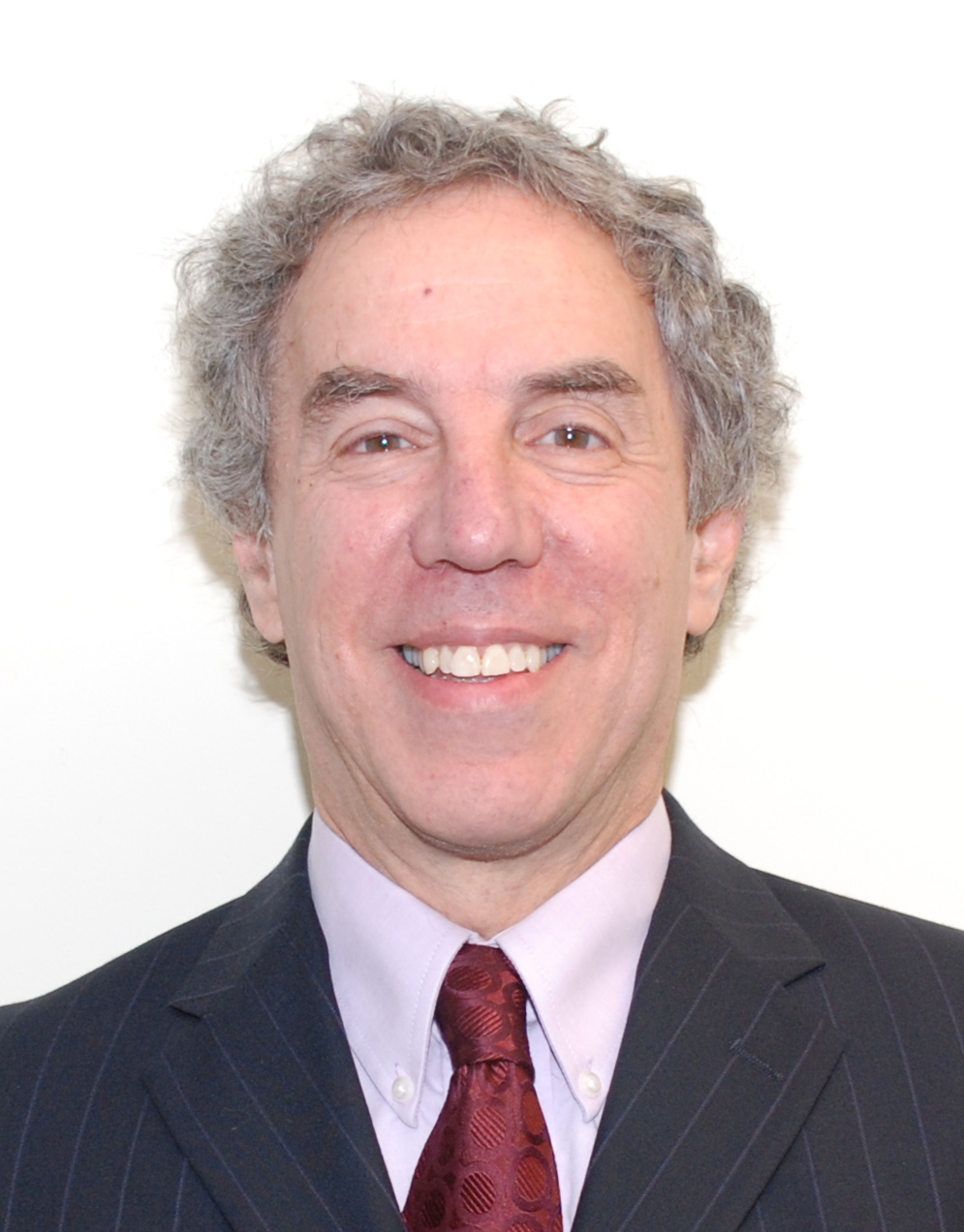
Warren Leon is the executive Director of the Clean Energy States Alliance. (Photo: courtesy of Mr. Leon)
LEON: Well what's happened Kansas is there is strong bipartisan support for renewable energy development. There are some folks who want to get rid of it so it's a battle and they'll certainly be efforts again this year to roll it back in Kansas and we'll have to see. On the other hand we need to keep in mind that at the same time there are states like Kansas where they're going to be efforts to roll back the RPS, they're going to be other states like Maryland and Illinois and Michigan where there will be efforts to strengthen the RPS this year. And there's going to be a strong effort that's underway in the state of Vermont to establish a renewable portfolio standard for the first time. So things move in both directions and it's a complicated situation.
CURWOOD: How does today's climate and enthusiasm for it compare to past years?
LEON: In some ways the fact that renewable energy is politically contentious now is in part a result of its success. Twenty years ago, nobody was opposing the development of renewable energy because fossil fuel and interests and those who in theory didn't like renewable energy all that much didn't see it as much threat. They didn't see that it had the potential to significantly reduce the use of fossil fuels, so what's happened now is renewable energy, the cost has come down, the share of the electricity that comes from renewables has gone up enough that it's now a serious force in the energy landscape. And it's going to continue to increase if current trends continue.
CURWOOD: Look into your crystal ball...30 years from today, which is the lifetime of the power plant, what you think the percentage of renewable energy will be at that point?
LEON: The use of renewable energy is clearly increasing in states across the country. Thirty years from now it will be well over half. I am optimistic the technologies are getting better, that cost is coming down, the reality of climate change is going to become ever more apparent and I have faith in the public in this country and even in the policymakers that they will take actions that will transform our electricity system and make it cleaner and more renewable.
CURWOOD: Warren Leon is Executive Director of the Clean Energy States Alliance. Thanks so much for taking the time with us today.
LEON: Thank you.
Related links:
- Study: Ohio's Renewable Energy Freeze Slows Wind and Solar
- Indiana Senate panel passes bill that would let utilities set their energy-efficiency goals
- http://www.foxbusiness.com/markets/2015/01/22/indiana-senate-panel-passes-bill-that-would-let-utilities-set-their-energy/
- American Legislative Exchange Council’s (ALEC) Renewable Energy Credit Act
- State-Federal RPS Collaborative helps implement and manage states’ RPS
- Clean Energy States Alliance—A Status Update on Renewable Portfolio Standards
- https://vimeo.com/111143755
- Warren Leon is the Executive Director of the Clean Energy States Alliance
Advances In Storage for Renewable Energy
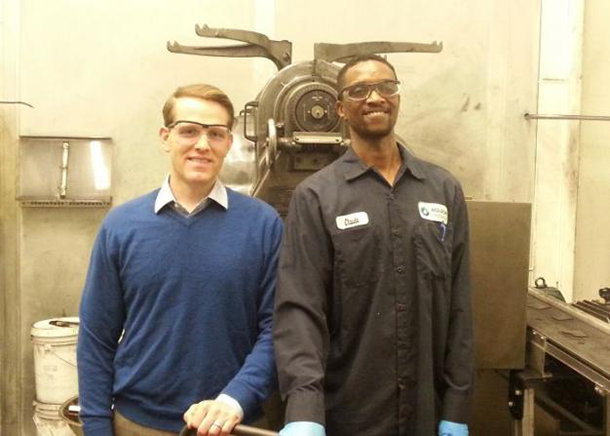
Ted Wiley and Claude Griffin with the rotary dial press at Aquion Energy in Pittsburgh. (Photo: Kara Holsopple/Allegheny Front)
CURWOOD: Solar energy is booming in America, with 100 percent growth last year at the utility scale, but like the wind, it is not a constant or always predictable supplier of power. So along with the solar revolution there is an energy storage revolution underway, though it is lagging well behind the growth in renewables. Some folks are trying to invent new forms of storage including batteries, but there are also enterprises that are tweaking existing technology in ways to make renewables more viable alternatives to the always available nuclear, gas and coal-fired power plants. The Allegheny Front’s Kara Holsopple visited one such firm in Pittsburgh.
[Whirring industrial sound]
HOLSOPPLE: Ted Wiley doesn’t look like your typical company vice president. He’s young, and wearing a casual blue sweater. We’re at Aquion Energy’s small warehouse near the river in Pittsburgh. Wiley puts on clear safety glasses, and leads me down a ramp and into a room that houses the rotary dial press.
WILEY: It’s a 10-ton press and we use it to press the powders that we make one of the electrodes in our battery with.
HOLSOPPLE: The machine isn’t really high tech. Similar models press powder into aspirin. This one spits out black pellets...
WILEY: ...looks kind of like one of the sides of an Oreo cookie. [ NAT Thump as they are pressed and move down the belt]
HOLSOPPLE: With each thump, another electrode is born. That’s where energy is stored in the batteries the company produces in their actual factory in a nearby county.
[Sounds fade]
So the equipment is ordinary--even the basic battery technology is like any rechargeable battery--like the one in your cell phone. But those are mostly lithium ion batteries. They’ve been around for decades. But Wiley says they used to be too expensive for common usage.
That changed when handheld devices became popular in the early 2000s.
Production ramped up, and prices dropped. Wiley says that’s when the batteries became feasible for larger scale energy storage. And that’s been a game changer for renewables, like solar.
WILEY: Before it was on the order of 10 or 20 X too expensive. Now it’s starting to get to a price point where in certain instances, it looks reasonable.
HOLSOPPLE: Especially in places like California, where solar is a bigger part of the energy mix, and there’s more interest in storing power from the sun.
The rush for better lithium ion batteries has benefitted newer technology companies like Aquion. Wiley says Aquion has taken battery technology a step further--their components are more environmentally friendly--it’s a water-based battery. And less expensive to produce than more traditional batteries.
Even in Pennsylvania where there is plentiful and cheap natural gas and coal--and less sun--there’s interest in renewable energy storage. It means solar and wind power can be used as backup--for example, during outages. And with a cleaner carbon footprint.
HAMILTON: I like to say energy storage is the bacon of the grid because it makes everything better.
HOLSOPPLE: Katherine Hamilton is with 38 North Solutions, a clean energy consulting firm in Washington, D.C.
She says energy storage is so delicious because helps make the grid more efficient and reliable. Solar panels capture the energy, and batteries hold it until it’s needed.
Hamilton says the federal government helped create a market for renewable storage a couple of years ago. It allowed for compensation of any system that helps the grid in times of need, like during extreme cold or heat, when people are using more energy.
But Pennsylvania’s leading environmental group says the push for solar storage puts the cart before the horse.
PennFuture’s Evan Endres says solar energy currently comprises less than one percent of the state’s energy.
ENDRES: The discussion really needs to be about how we get renewable energy on the system that we have right now…
HOLSOPPLE: Endres says when Pennsylvania reaches 12 or 15 percent solar, like in West, then it makes sense to get more excited about storage.
Pittsburgh-based Aquion admits its customer base is currently in sunnier places, like the Caribbean. But they expect other regions will warm up to solar storage in the near future.
For The Allegheny Front, I’m Kara Holsopple.
CURWOOD: Kara Holsopple is with the public radio program, the Allegheny Front.
Related link:
Aquion Energy
Beyond the Headlines

The New Jersey’s Chris Christie office is settling an 11-year-old pollution lawsuit against Exxon Mobil Corp. for a fraction of what it originally sought – just three cents on the dollar. (Photo: Thomas Hawk; Flickr CC BY-NC 2.0)
CURWOOD: Time for our weekly trip beyond the headlines. Peter Dykstra has been exploring that universe. He’s with the DailyClimate.org and Environmental Health News, that’s EHN.org. He’s on the line from Conyers, Georgia, now. Hello, Peter, what was remarkable this week?
DYKSTRA: Hi, Steve, two of the easiest targets for political humor in this country are lawyers and New Jersey.
CURWOOD: Ah so I take it we’re going back to your ancestral home?
DYKSTRA: Briefly, as the latest example of how difficult it is to pursue environmental lawsuits, particularly if the defendant has deep pockets. In a lawsuit filed 11 years ago, the state of New Jersey sought $8.9 billion dollars from Exxon Mobil for wetlands destruction and contamination around the Bayway refinery, just south of Newark Airport. That’s just by that section of the New Jersey Turnpike where you have to roll the windows up.
CURWOOD: Oh, yeah. That really stank down there. That was the stuff of legend.
DYKSTRA: Well, Exxon no longer owns the Bayway refinery, but a judge had already ruled that the company is liable. All that remained in the case was for the court to decide whether Exxon owed the full $8.9 billion. But New Jersey abruptly settled with Exxon, taking the decision out of the judge’s hands, and they settled for $250 million - about three cents on the dollar.
CURWOOD: So no one ever got near Exxon’s deep, deep pockets.
DYKSTRA: Correct. And the state has also given itself the right to use most of that smaller settlement not on environmental cleanup, but however it sees fit. As of last year, there’s a budget provision saying New Jersey can divert anything over $50 million from an environmental lawsuit to things like plugging holes elsewhere in the state budget. They did exactly that with a recent $190 million settlement over contamination in the Passaic River. Want a couple of other shining examples of failure in environmental litigation?
CURWOOD: Go ahead. Sure.
DYKSTRA: In 2003, Monsanto agreed to a $600 million dollar settlement for PCB contamination in Anniston, Alabama. Lawyers with no PCB exposure got 39 percent of the money, including the late legendary Johnny Cochran whose law firm pulled down $40 million. Those PCB-exposed victims got an average of $9,000 dollars from the settlement, and after the 1989 Exxon Valdez oil spill, victims waited over two decades for compensation. One-sixth of them had died before the checks were mailed. And of course, the 2010 BP spill in the Gulf of Mexico is still playing out in both civil and criminal court.
CURWOOD: And I imagine those checks will be a long time coming in the mail. What’s next?
DYKSTRA: Investigative environmental reporting and a viral video in China. Chai Jing is a former news anchor who produced “Under the Dome,” a documentary on the sources and consequences of China’s massive pollution problems. She went into her own pockets to fund the production, and it managed to both escape censorship and draw a 100 million online views in its first seventy-two hours. Can you imagine getting millions of viewers on an environmental video here?
CURWOOD: No, I can't. Do you think it could be the same kind of wake-up call for China that Rachel Carson’s Silent Spring, about the environmental effects of pesticides was for America?
DYKSTRA: We'll see. The Chinese government may or may not fully block the video. At the time, we recorded this, they only took the step of discouraging further reporting on it. But 100 million viewers means that it's already out of the bag.
CURWOOD: Yeah, and people here can link to the Chinese pollution video and all our news at our website LOE.org. What’s on the history calendar this week?
DYKSTRA: I’ve got a weird one for you.
CURWOOD: And that’s unusual, Peter?
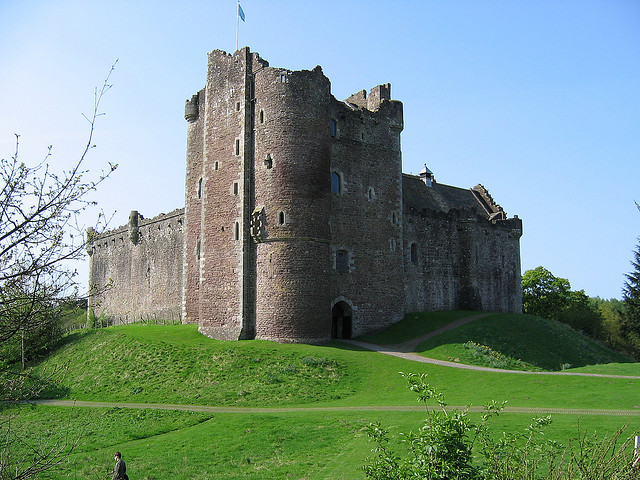
Scotland’s Doune Castle, where scenes of Monty Python and the Holy Grail were filmed, is home to a small population of Pipistrelle bats in the wintertime. (Photo: alialliallie, Flickr CC BY-NC-ND 2.0)
DYKSTRA: Whatever. The pipistrelle is a bat species found in Scotland, but for years, no one could figure out where these tiny winged mammals hang out. But in 2008, seven years ago this week, a shocking discovery by our radio friends at the BBC. One of the favorite roosts for the pipstrelle is Doune Castle, built in the 13th Century, restored in the 1880s, and in 1975, briefly occupied by John Cleese in Monty Python and the Holy Grail as he and other French soldiers hurled insults at King Arthur.
CURWOOD: So the pipistrelle and Monty Python share the same habitat?
DYKSTRA: Well they did at least briefly, but Doune Castle has become a tourist attraction for four different reasons: bat lovers, history buffs, scientists and Monty Python fans. Years earlier, the castle was used in the movie “Ivanhoe,” and recently, it was a TV backdrop for “Game of Thrones.”
CURWOOD: But not for Batman?
DYKSTRA: Well, there have only been seven movies so far, so give it time.
CURWOOD: Peter Dykstra is with Environmental Health News, that's EHN.org, and the DailyClimate.org. Talk to you soon, Peter!
DYKSTRA: Alright. Thanks a lot, Steve. We'll talk to you soon, “same bat time, same bat channel”.
Related links:
- “Administration Reportedly Settles $8.9B Exxon Lawsuit In A Hurry – For Only $250M”
- Excerpt of Language from 2014 Budget
- “Money Grab”: Monsanto settlement for contaminating a town with PCBs yields inequitable payouts
- “This viral documentary is challenging China’s powerful polluters – and skirting censors”
- “Holy Grail castle in bats mystery”
[MUSIC: The Ventures--Batman]
CURWOOD: Just ahead...the promise and problems of a new canal to link the Atlantic and Pacific. That's coming up on Living on Earth. Stay tuned.
ANNOUNCER: Funding for Living on Earth comes from United Technologies, a provider to the aerospace and building systems industries worldwide. UTC Building & Industrial Systems provides building technologies and supplies, container refrigeration systems that transport and preserve food, and medicine with brands such as Otis, Carrier, Chubb, Edwards and Kidde. This is PRI, Public Radio International.
[CUTAWAY MUSIC: Steve Reich--Music for 18 Musicians II Section 1, Music for 18 Musicians, Nonesuch 2005]
BirdNote: Eating Well Together

Golden-crowned Kinglet (Photo: Eugene Beckes)
CURWOOD: It's Living on Earth, I'm Steve Curwood.
[MUX - BIRDNOTE® THEME]
CURWOOD: Even where winter still holds its grip – longer days and the first day of spring in less than two weeks promise that warmer days and the growing season will finally arrive. And then there’s the promise we can find in flocks of wild birds. Here’s Mary McCann with today’s Birdnote®.
BirdNote®
Flocking and Foraging
[Winter flock of chickadees and kinglets]
MCCANN: Take a walk in a temperate woodland this month, and you might hear this chorus.
[Winter flock of chickadees and kinglets and Downy Woodpecker]
A closer look and listen reveals that this foraging flock includes several species of birds: chickadees, kinglets, and even a Downy Woodpecker.
[Downy Woodpecker]
Many bird species eat alone, so you might wonder why these birds have chosen to dine together.
Different species flocking together to find food, called commensal feeding, mutually enhances success. One species assists the foraging of others.
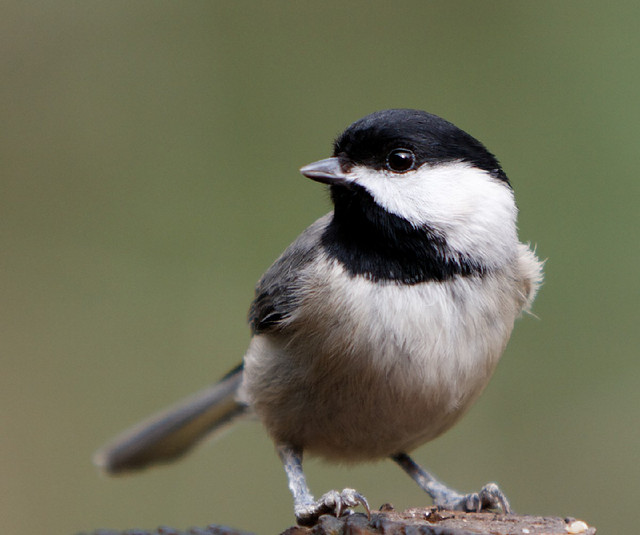
Black-capped Chickadee (Photo: Les Howard)
For example, in chickadee and woodpecker flocks, the woodpecker pecks off bark and moss, exposing grubs for its own consumption. But the pecking also stirs up flying insects that the chickadees swoop in to snatch.
The relationship also helps the woodpecker, because the extra eyes of the chickadees are on the lookout for predators. The watchdog chickadees alert the close-focused woodpecker when there’s danger.
[Chickadee sounding the notes of danger]
Because these birds, foraging together, don’t seek the same foods, the result is cooperative—or commensal—rather than competitive feeding.
[More flock with Downy Woodpecker]
I’m Mary McCann
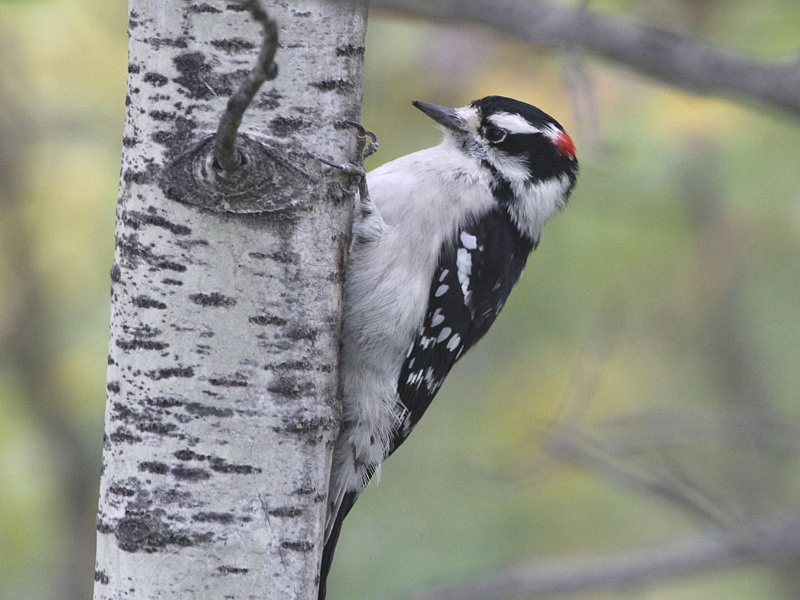
A male Downy Woodpecker (Photo: Vitalii Khustochka)
###
Written by Frances Wood
Birdcalls provided by The Macaulay Library of Natural Sounds at the Cornell Lab of Ornithology, Ithaca, New York. Black-capped chickadee recorded by R.S. Little; Golden-crowned Kinglets by G.A. Keller, Downy Woodpecker call, by W.W.H. Gunn; and mixed flock by J. Storm.
Black-capped Chickadee 5 “dee” call recorded by C. Templeton
Photos: Black-capped Chickadee - Les Howard flickr.com/photos/leshoward/; Downy Woodpecker - Vitalii Khustochka flickr.com/photos/phenolog/; Golden-crowned Kinglet - Eugene Beckes flickr.com/photos/61210501@N04
Producer: John Kessler
Executive Producer: Chris Peterson
© 2015 Tune In to Nature.org Feb. 2015 Narrator: Mary McCann
http://birdnote.org/show/flocking-and-foraging
CURWOOD: To find photos and more...flock on over to our website. It’s LOE.org.
Related link:
More on Commensal Feeding on BirdNote
Nicaraguan Canal Could Be Environmental Catastrophe
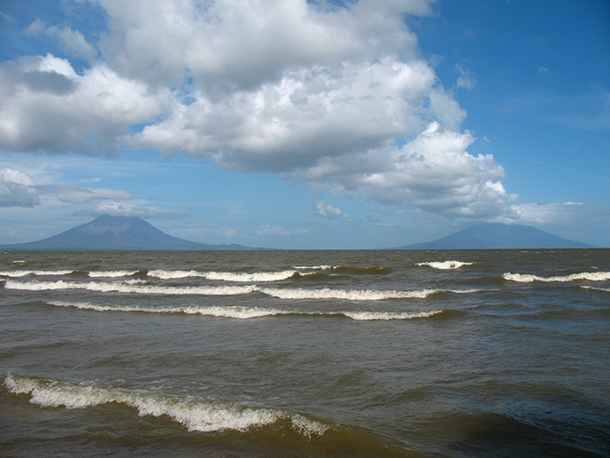
The Nicaragua Canal would go through Lake Nicaragua, one of the largest lakes in the Americas (photo: Robert Blackie; Flickr CC 2.0)
CURWOOD: The Panama Canal is only route through the American Continent for cargo ships. But that could soon change, as Chinese business have been granted a concession by the Nicaraguan government to construct a competing canal through that small Central American country, crossing the mighty Lake Nicaragua in the process. But the idea to build a canal through Nicaragua is not new.
HUETE-PERÉZ: The first people that suggested about this canal that needed the connection between the Caribbean and the Pacific were the Spanish. That was 500 years ago. But then we've had other world powers very interested in that, including the English, Holland, Belgium, even Napoleon had an interest in this canal.
CURWOOD: That's Professor Jorge Huete-Pérez, Director of the Molecular Biology Center at the University of Central America in Managua, Nicaragua. Professor Huete says information about the Chinese company running this project is hard to come by.
HUETE-PERÉZ: We don't know much about this company. What we know is that they don't have much experience in terms of construction. So it came as a surprise, knowing that the Nicaraguan government has decided to give them a concession for 100 years. The concession is actually not just for the canal construction but is a big combo. There are about eight projects, and all of them are really large infrastructure projects. It includes projects that don't seem related to a wet canal, such as infrastructure for tourism. And it's also difficult for us to analyze because there's also not much public information about all of these projects.
CURWOOD: Professor Huete, how far along are we in this process? Have they broken ground?
HUETE-PERÉZ: Well, they started the project last December. It was a grandiose celebration, but what they've done is mostly that big opening. As a matter of fact, all they have is like 20 people widening the road that they need to get to ports. So it's more like a propaganda thing that they did last December. However, what people are saying is that this is a big symbol because what they want to tell us is that they are going to go ahead with a project in spite of them not having any environmental or social studies performed or finished. And people are very concerned because there's not much information, there's no transparency and there's no public debate regarding all these issues.
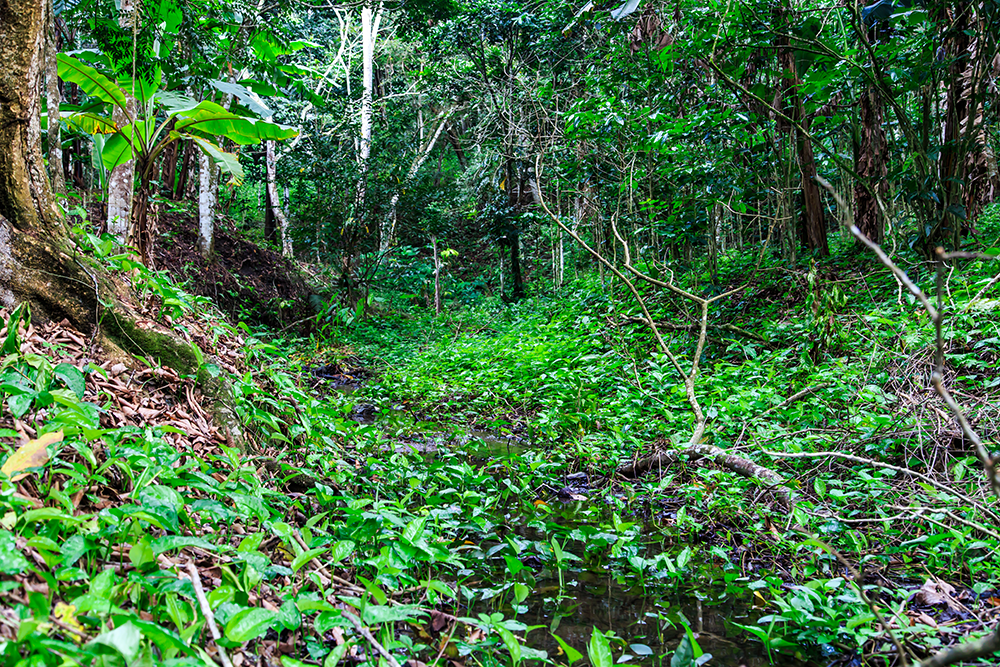
The construction of the canal would need to break through several sensitive rainforests (Photo: Bigstockphoto)
CURWOOD: Now, please describe the route of the canal that is being proposed. Where would this be built and how big would it be?
HUETE-PERÉZ: So you know it's a very large project. It is about three times as large as the Panama Canal. If we go looking at the map from the Pacific all the way to the Caribbean, it's about 20 kilometers between the Pacific Ocean and the lake, then you go through the lake about 100 kilometers and then you come out at the center of the country and then you have to find a way to get to the Caribbean.
So the problem you find there is that you have to go and break through very important world-recognized wetlands, and you have to go also through to very special forests in the Caribbean, and there's no way they can avoid those forests, so they're going to have to break through and that's a very serious concern.
CURWOOD: What are your concerns from an environmental perspective? What's at stake here?
HUETE-PERÉZ: Well what is a very wealthy country in terms of biodiversity. We have around 7 to 8 percent of the world's biodiversity in Nicaragua. There are more than 70 different ecosystems. Just in the lake we would have more than five different ecosystems in that mass of water. So in terms of conservation, Nicaragua is a very important place, and you have to remember that Nicaragua is also a very important point for the Meso-American biological corridor, which is a corridor set to conserve the biodiversity of the area. Now as you can imagine, by building this canal, the construction itself is going to produce a lot of damage in the lake and all the other areas where it's going to go through. Regarding the forest, we have calculated that at least 20 to 25 different species that are a threatened species will be affected by the construction of this canal.
CURWOOD: Now, what about Lake Nicaragua itself? It's, what, one of the largest lakes in the western hemisphere. How concerned are you about water pollution?
HUETE-PERÉZ: What scientists are thinking is that this is very important for the future. So far, people drink from that water. They use it for households. People use the lake for fishing especially the small poor communities around the lake, but it's a huge mass of water. It's more than 8,000 square kilometers. This lake, it's as big as El Salvador in Central America. So this lake is very important for the future. Nicaragua is one of the countries most affected by climate change. There's long periods of the droughts in this country, and people know that for future this is going to be very important for drinking water.
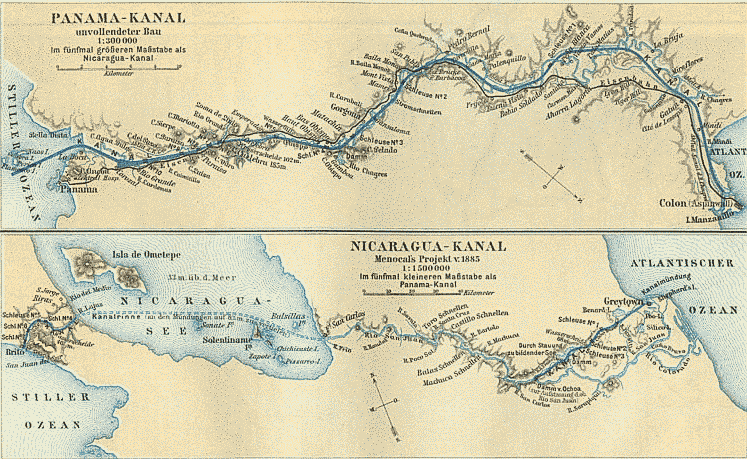
Historic map of the unfinished Panama Canal and the planned Nicaraguan Canal. A canal through Nicaragua was actually the United States’ first choice route through Central America. (Photo: Wikipedia, public domain)
CURWOOD: What about the impact of the canal on people? How will it affect any of the indigenous people who live in that area?
HUETE-PERÉZ: Right. There's going to be plenty of people that are going to have be displaced from those areas. The Humboldt center in Nicaragua is a very important research center in Central America, has calculated that at least 30,000 up all the way to 100,000 people that will probably be displaced by this canal. The government plays down this number and thinks that it is going be more like 7,000 to 10,000 people, but what we need to say about this is that there are very important indigenous populations in these areas. And this brings us to the legality of this canal. There has been 39 different legal complains to the Supreme Court regarding this canal, and one of these complaints is from the indigenous communities because according to the Constitution of Nicaragua those lands are autonomous lands, they're very important for these communities. That's the way they live. You cannot touch that land. You cannot grant it. You cannot buy it. So how come they're pretending to do this canal without even consulting these communities. I have said before that I considered this project absolutely racist. It's a way of looking at this area, they come and tell you you're going to have to be displaced and you're going to have a better life because we the people in Pacific area decided that you're better off with a different life and we need a canal. I really think we should be paying attention to this from the point of view of human rights.
CURWOOD: Now, the Nicaraguan government is saying this project is going to help lift their country out of poverty. What do you think about that?
HUETE-PERÉZ: Right. Well you know those are the selling points that they have. One has to remember that Nicaragua is one of the poorest countries in the hemisphere and there is unemployment problems, very serious. People are half-employed, self-employed. So when you bring a project like this, it has all the elements to be a very public project because they claimed that it's going to eradicate poverty in Nicaragua, everybody's going to have jobs, everybody's going to be rich overnight, but this might be an economic project and a financial project, but it's not at all a sustainable development project. It's not scientifically sound. It's not sustainable at all.
CURWOOD: Jorge what do you think China's goals are here?
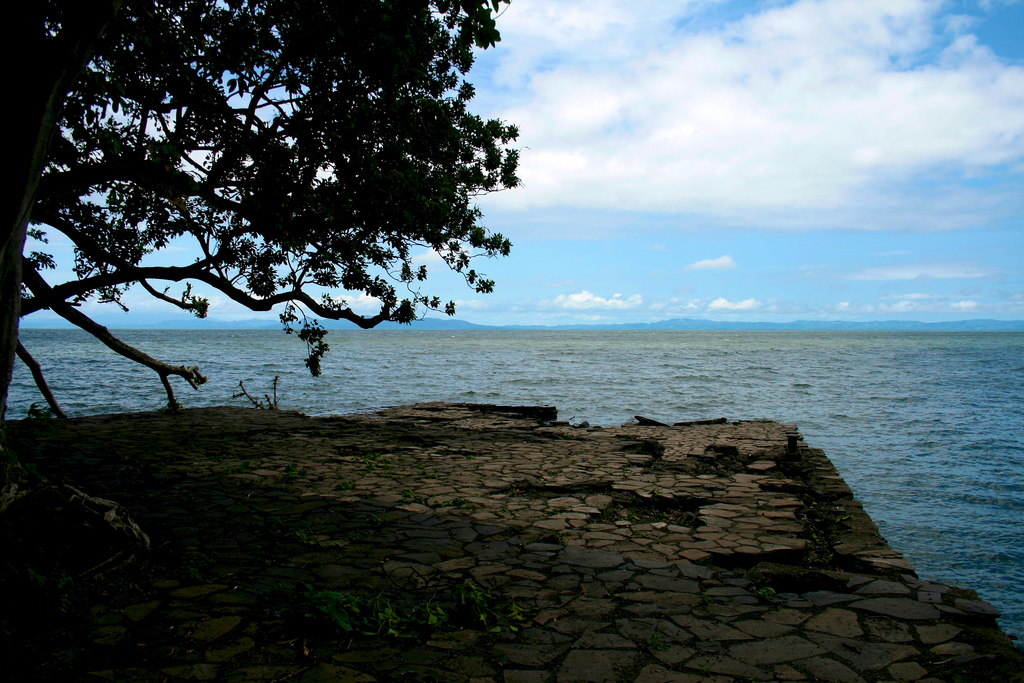
The view of Lake Nicaragua from Ometepe Island, a UNESCO World Heritage Site (Photo: Lizzie Jespersen, Flickr CC 2.0)
HUETE-PERÉZ: You know that's not my area of expertise, but I'll tell you what I think. A lot of the experts that are talking about these issues, they think that there are geostrategic implications that are favorable for China for them to have a major influence in the Americas. Now, one of the things that is really concerning is the way they're pushing this project doesn't seem like they care much about the environment, it doesn't seem like a care much about human rights. That's a serious concern. You have Chinese people coming into your land with armed escorts from the Army getting into different places and saying, "This is going to be for the canal and we need this property," and is very scary for indigenous people in Nicaragua.
CURWOOD: So Professor, at the end of the day where do you see this thing headed?
HUETE-PERÉZ: Well, the plan that the government has announced, and the Chinese planners as well have talked about, is that somewhere in April or May they are going to start displacing people. That's not going to go that easy because people will be protesting and I don't think people are willing to give their lands to the Chinese companies that are running the project. Last December when this project was open, there were people that were protesting and the government responded with the police, with the army, they militarized some of the areas, they put people in jail. So the scientific community, what we're thinking is that we would like the international community to get involved in analyzing from the point of view of the environment, from the view of human rights, all these issues, and trying to offer help to Nicaragua so that if the project goes ahead, its difficulties are mitigated properly.
CURWOOD: Jorge Huete-Pérez is the Director of the Molecular Biology Center at the University of Central America. Thanks so much for joining us.
HUETE-PERÉZ: Thank you so much, Steve.
CURWOOD: We tried repeatedly to get comment from the Government of Nicaragua through its embassy in Washington, but our calls and emails went unanswered.
Related links:
- Jorge Huete Perez is a professor at the University of Central America
- Check out more on the canal and its impacts
Listener Letters and A Fun Lesson on Thermodynamics

Michael Flanders and Donald Swann are British comedians. (Photo: Bill Doll and Company, New York-publicity agency; Wikimedia commons)
[LETTERS THEME MUX]
Time now to hear from you, our listeners.
[MORE THEME]
One of our recent stories elicited a lively exchange. It was an interview with Lawrence Orsini, founder of Project Exergy, a company that is investigating capturing waste heat from computing to heat homes. A lot of you apparently were confused, or even thought we had the science wrong, including John F. Williams who wrote that our interview failed to display “a basic understanding of the science fundamentals,” and thus came across as “magic disguised as science.”
And Frank Gould wrote:
"Of course it makes sense to capture the electrical energy consumed and converted to heat by computers (or any other electrical device) before it is dissipated. But there is such a thing as "conservation of energy". Computers are not going to magically produce more energy than they consume.

Project Exergy's prototype is called Henry (Photo: Project Exergy)
So Lawrence Orsini responded directly to Frank:
You are right, he wrote, that the conservation of energy law cannot be broken, and what we are proposing does not attempt. Instead of running computers just to create heat, our concept is to perform beneficial computation, computation that the house, building, and the world are already using in rapidly increasing quantities. We are hoping to move existing electric consumption associated with computation happening in datacenters to buildings that are consuming energy today just to make heat. This computation-generated heat can DISPLACE energy that the building would otherwise use for one purpose (heat) and instead provide heat AND computation for less energy than datacenters are using today.
Orsini’s colleague John Lilic asserts that there is enough waste heat generated in US data centers to heat two-thirds of the homes in America.
He adds that Datacenters are using a significant portion of the energy they consume to remove heat from the servers using large cooling systems.
The heat we will generate is removed from the computer by serving an existing heat load, so the inefficiency of removing heat from the computing system with air conditioners and chillers is eliminated in our model.
And what about the summer?
Orsini says the same principles behind the technology that is used in propane refrigerators can be used to power air conditioning from waste heat.
So it’s not magic, it’s physics.
And we have had good instruction in the laws of thermodynamics, thanks to the British duo, Michael Flanders and Donald Swann.
[MUSIC: The Cinematic Orchestra--Just One Day, The Crimson Wing: Mystery of the Flamingo, Ninjq Tune 2005]
The First Law of Thermodynamics:
Heat is work and work is heat
Heat is work and work is heat
Very good! The Second Law of Thermodynamics:
Heat cannot of itself pass from one body to a hotter body
Heat cannot of itself pass from one body to a hotter body
Heat won't pass from a cooler to a hotter
Heat won't pass from a cooler to a hotter
You can try it if you like but you'd far better notta
You can try it if you like but you'd far better notta
'Cos the cold in the cooler will get hotter as a rule-a
'Cos the cold in the cooler will get hotter as a rule-a
'Cos the hotter body's heat will pass to the cooler
'Cos the hotter body's heat will pass to the cooler
Good, First Law!
Heat is work and work is heat
And work is heat and heat is work
Heat will pass by…conduction
Heat will pass by…conduction
And heat will pass by…convection
Heat will pass by convection
And heat will pass by…radiation
Heat will pass by…radiation
And that's a physical law!
Heat is work and work's a curse
And all the heat in the Universe
Is gonna cooooool down 'cos it can't increase
Then there'll be no more work and there'll be perfect peace!
Really?
Yeah, that's entropy, man!
And it’s all because of the Second Law of
Thermodynamics, which lays down that…
You can't pass heat from a cooler to a hotter
Try it if you like but you far better notta
'Cos the cold in the cooler will get hotter as a rule-a
'Cos the hotter body's heat will pass to the cooler
Oh you can't pass heat, cooler to a hotter
Try it if you like but you'll only look a fool-a
'Cos the cold in the cooler will get hotter as a rule-a
And that's a physical law!
Oh, I'm hot!
Hot? That's because you've been working!
That's the first and second law of thermodynamics.
CURWOOD: That’s Michael Flanders, with Donald Swann at the piano, explaining the laws of thermodynamics, back in 1964. And remember, your comments on our program are always welcome. Call our listener line anytime at 800-218-9988. That's 800-218-9988. Our e-mail address is comments at LOE.org. That’s comments at LOE.org.
Related links:
- Project Exergy
- http://projectexergy.com/
[MUSIC: Doctor L--Energy, We Got Lost, Planet Woo Dizziness 2012]
CURWOOD: Living on Earth is produced by the World Media Foundation. Our crew includes Naomi Arenberg, Bobby Bascomb, Emmett Fitzgerald, Helen Palmer, Adelaide Chen, Jenni Doering, Lauren Hinkel, James Curwood, Jennifer Marquis, and John Duff. Our show was engineered by Tom Tiger, with help from Jake Rego, Noel Flatt. Alison Lirish Dean composed our themes. You can find us anytime at LOE.org - and like us, please, on our Facebook page - it’s PRI’s Living on Earth. And we tweet from @LivingOnEarth. I'm Steve Curwood. Thanks for listening.
ANNOUNCER1: Funding for Living On Earth comes from the Grantham Foundation for the protection of the environment, supporting strategic communication and collaboration in solving the world’s most pressing environmental problems. The Kendeda Fund, furthering the values that contribute to a healthy planet, and Gilman Ordway for coverage of conservation and environmental change. Living on Earth is also supported by Stonyfield Farm, makers of organic yogurt, smoothies and more; www.stonyfield.com.
ANNOUNCER2: PRI. Public Radio International
Living on Earth wants to hear from you!
Living on Earth
62 Calef Highway, Suite 212
Lee, NH 03861
Telephone: 617-287-4121
E-mail: comments@loe.org
Newsletter [Click here]
Donate to Living on Earth!
Living on Earth is an independent media program and relies entirely on contributions from listeners and institutions supporting public service. Please donate now to preserve an independent environmental voice.
NewsletterLiving on Earth offers a weekly delivery of the show's rundown to your mailbox. Sign up for our newsletter today!
 Sailors For The Sea: Be the change you want to sea.
Sailors For The Sea: Be the change you want to sea.
 The Grantham Foundation for the Protection of the Environment: Committed to protecting and improving the health of the global environment.
The Grantham Foundation for the Protection of the Environment: Committed to protecting and improving the health of the global environment.
 Contribute to Living on Earth and receive, as our gift to you, an archival print of one of Mark Seth Lender's extraordinary wildlife photographs. Follow the link to see Mark's current collection of photographs.
Contribute to Living on Earth and receive, as our gift to you, an archival print of one of Mark Seth Lender's extraordinary wildlife photographs. Follow the link to see Mark's current collection of photographs.
 Buy a signed copy of Mark Seth Lender's book Smeagull the Seagull & support Living on Earth
Buy a signed copy of Mark Seth Lender's book Smeagull the Seagull & support Living on Earth

